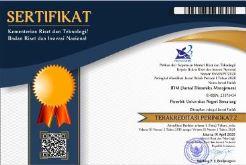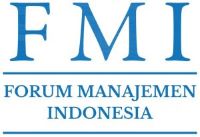The Role of Current Ratio, Operating Cash Flow and Inflation Rate in Predicting Financial Distress: Indonesia Stock Exchange
Abstract
We believe company financial statements can be used as a tool to analyze and also as an indicator to know the financial performance. The financial statements contain information for various financial ratios, which are an important tool for assessing the company’s financial performance in the future. The purpose of this research is to know the role of the current ratio, operating cash flow, and the inflation rate in predicting financial distress of consumer goods industry sector listed in the Indonesia Stock Exchange period 2011–2015. Financial distress prediction models need to be developed to assist managers in overseeing company performance and help identify important trends. To analyze the current ratio, operating cash flow, and the inflation rate has a probability of occurring financial distress for the company, used logistic regression. From this study resulted in the finding that the probability of a company exposed by financial distress is caused by operating cash flow, while the current ratio and the inflation rate have a smaller probability of the company of consumer goods to be exposed by financial distress.
Keywords
Full Text:
PDFReferences
Ahmed, H. (2009). Financial Crisis : Risks and Lessons for Islamic Finance. ISRA International Journal of Islamic Finance, 1(1), 7-32.
Dutta, A., Bandopadhyay, G., & Sengupta, S. (2012). Prediction of Stock Performance in Indian Stock Market Using Logistic Regression. International Journal of Business and Information, 7(1).
Frydman, H., Altman, E. I., & Kao, D. L. (1985). Introducing Recursive Partitioning for Financial Classification: the Case of Financial Distress. The Journal of Finance, 40(1), 269-291.
Geng, R., Bose, I., & Chen, X. (2015). Prediction of Financial Distress: an Empirical Study of Listed Chinese Companies Using Data Mining. European Journal of Operational Research, 241(1), 236-247.
Habib, A., Uddin Bhuiyan, B., & Islam, A. (2013). Financial Distress, Earnings Management and Market Pricing of Accruals During the Global Financial Crisis. Managerial Finance, 39(2), 155-180.
Hox, J. J., Moerbeek, M., & Van de Schoot, R. (2017). Multilevel Analysis: Techniques and Applications. New York: Routledge.
Hui, L. B. (2014). Corporate Failure Prediction of Public Listed Company in Sarawak. Unpublished Thesis. Malaysia: Universiti Malaysia Sarawak.
Jovanović, D., Todorović, M., & Grbić, M. (2017). Financial Indicators as Predictors of Illiquidity. Romanian Journal of Economic Forecasting, 20(1), 128.
Kam, A., Citron, D., & Muradoglu, G. (2010). Financial Distress Resolution in China–two Case Studies. Qualitative Research in Financial Markets, 2(2), 46-79.
Lakshmanan, L., Felix, L. S. G., Nair, M. N. B., & Sahseetharan, T. (2017). A Study on the Prediction of Financial Distress in Malaysia. Unpublished Thesis. Malaysia: Universiti Tunku Abdul Rahman.
Listyaningsih, E., & Krishnamurti, C. (2015). How Performance of Jakarta Islamic Index (JII) Stocks Relative to other Stocks?. Jurnal Dinamika Manajemen, 6(2), 145-164.
Malinić, D. (2013). Insufficiency of Serbian Economy’s Operating Performances: Manifestations, Causes and Main Guidelines of Recovery. Ekonomika preduzeća, 61(1-2), 41-62.
Nisasmara, P. W., & Musdholifah. (2016). Cash Holding, Good Corporate Governance and Firm Value. Jurnal Dinamika Manajemen, 7(2), 117-128.
Riantani, S., & Nurzamzam, H. (2015). Analysis of Company Size, Financial Leverage, and Profitability and its Effect to CSR Disclosure. Jurnal Dinamika Manajemen, 6(2), 203-213.
Setyawati, I. (2016). Determinants of Growth and Profitability by Bank Specific Variable and Market Structure in Islamic Banking in Indonesia. Academy of Strategic Management Journal, 15, 1-14.
Setyawati, I., Suroso, S., Suryanto, T., & Nurjannah, D. S. (2017). Does Financial Performance of Islamic Banking is Better? Panel Data Estimation. European Research Studies Journal, 20(2), 592.
Simlai, P. (2014). Firm Characteristics, Distress Risk and Average Stock Returns. Accounting Research Journal, 27(2), 101-123.
Syamsudin, S., Imronudin, I., Utomo, S. T., & Praswati, A. N. (2017). Corporate Governance in Detecting Lack of Financial Report. Jurnal Dinamika Manajemen, 8(2), 167-176.
Tinoco, M. H., & Wilson, N. (2013). Financial Distress and Bankruptcy Prediction Among Listed Companies Using Accounting, Market and Macroeconomic Variables. International Review of Financial Analysis, 30, 394-419.
Uzhegova, O. (2015). The Relative Importance of Internal Factors for Bank Performance in Developed and Emerging Economies. Mediterranean Journal of Social Sciences, 6(3), 277-288.
Vinh, V. X. (2015). Using Accounting Ratios in Predicting Financial Distress : an Empirical Investigation in the Vietnam Stock Market. Journal of Economics and Development, 17(1), 41-49.
Yap, B. C. F., Munuswamy, S., & Mohamed, Z. (2012). Evaluating Company Failure in Malaysia Using Financial Ratios and Logistic Regression. Asian Journal of Finance & Accounting, 4(1), 330-344.
Yasser, Q. R., & Mamun, A. Al. (2015). Corporate Failure Prediction of Public Listed Companies in Malaysia. European Researcher, 91(2), 114-126.
Zhang, Z., Xie, L., Lu, X., & Zhang, Z. (2016). Determinants of Financial Distress in Large Financial Institutions: evidence from US Bank Holding Companies. Contemporary Economic Policy, 34(2), 250-267.
View Counter: Abstract - 5010 and PDF - 3114
Refbacks
- There are currently no refbacks.






